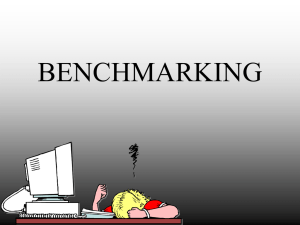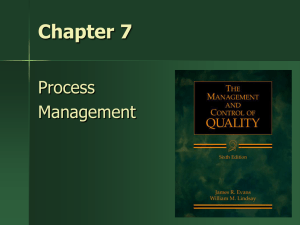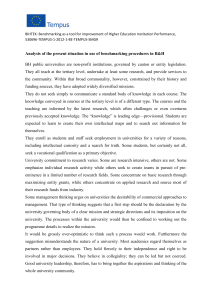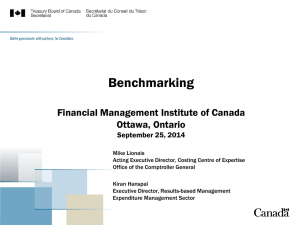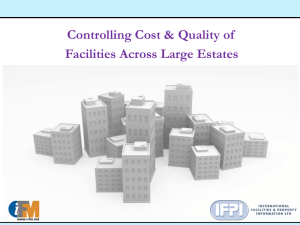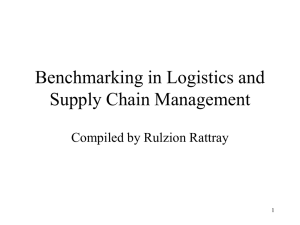A Proposal for Paper Presentation
advertisement
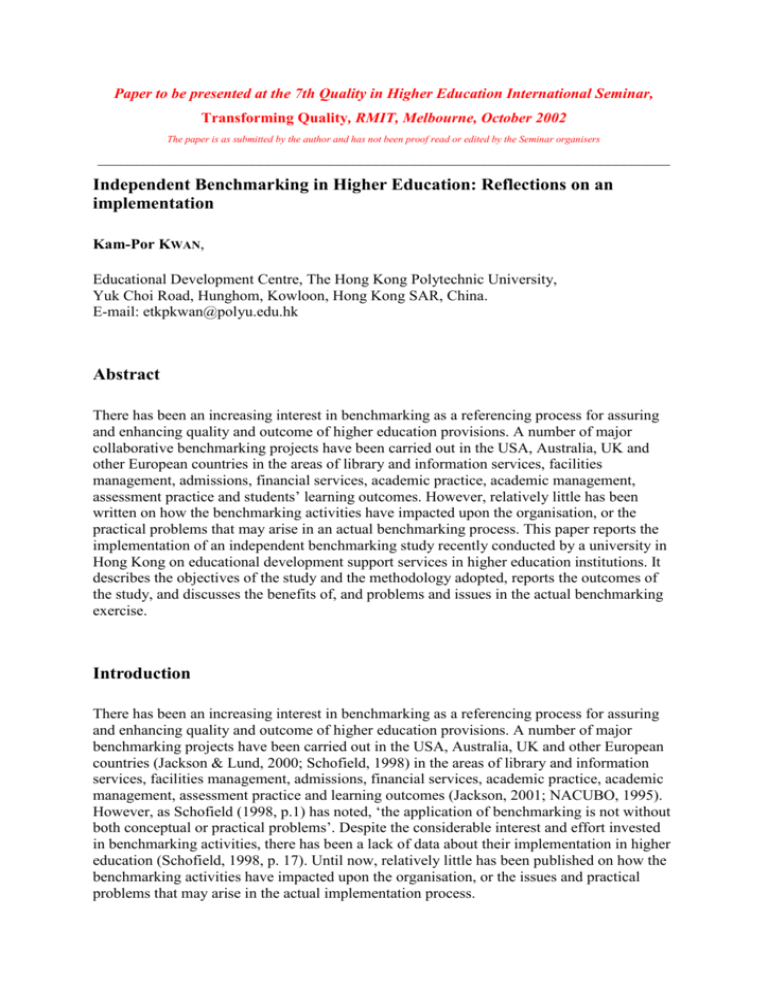
Paper to be presented at the 7th Quality in Higher Education International Seminar, Transforming Quality, RMIT, Melbourne, October 2002 The paper is as submitted by the author and has not been proof read or edited by the Seminar organisers __________________________________________________________________________ Independent Benchmarking in Higher Education: Reflections on an implementation Kam-Por KWAN, Educational Development Centre, The Hong Kong Polytechnic University, Yuk Choi Road, Hunghom, Kowloon, Hong Kong SAR, China. E-mail: etkpkwan@polyu.edu.hk Abstract There has been an increasing interest in benchmarking as a referencing process for assuring and enhancing quality and outcome of higher education provisions. A number of major collaborative benchmarking projects have been carried out in the USA, Australia, UK and other European countries in the areas of library and information services, facilities management, admissions, financial services, academic practice, academic management, assessment practice and students’ learning outcomes. However, relatively little has been written on how the benchmarking activities have impacted upon the organisation, or the practical problems that may arise in an actual benchmarking process. This paper reports the implementation of an independent benchmarking study recently conducted by a university in Hong Kong on educational development support services in higher education institutions. It describes the objectives of the study and the methodology adopted, reports the outcomes of the study, and discusses the benefits of, and problems and issues in the actual benchmarking exercise. Introduction There has been an increasing interest in benchmarking as a referencing process for assuring and enhancing quality and outcome of higher education provisions. A number of major benchmarking projects have been carried out in the USA, Australia, UK and other European countries (Jackson & Lund, 2000; Schofield, 1998) in the areas of library and information services, facilities management, admissions, financial services, academic practice, academic management, assessment practice and learning outcomes (Jackson, 2001; NACUBO, 1995). However, as Schofield (1998, p.1) has noted, ‘the application of benchmarking is not without both conceptual or practical problems’. Despite the considerable interest and effort invested in benchmarking activities, there has been a lack of data about their implementation in higher education (Schofield, 1998, p. 17). Until now, relatively little has been published on how the benchmarking activities have impacted upon the organisation, or the issues and practical problems that may arise in the actual implementation process. -2- This paper reports the implementation of an independent benchmarking study recently conducted by a university in Hong Kong to identify the key performance indicators for educational development support services in higher education institutions. It describes the objectives of the study and the methodology adopted, reports the outcomes of the study, and reflects on the benefits, problems and issues in the benchmarking exercise. Benchmarking and continuous quality improvement (CQI) There are many definitions of benchmarking (for example, Camp, 1989; Camp & Tweet, 1994; Jackson and Lund, 2000; Ottenhouse, 1994; Price, 1994). A careful review of the various definitions reveals that there are three major characteristics of benchmarking: It is a formal ongoing process of the institution’s quality assurance and improvement system rather than an ad hoc one-shot attempt for information gathering. It focuses not only on collecting performance data but also on understanding the process and seeking the best practices in similar institutions. The main purpose is to enable the benchmarking institution to achieve continuous quality improvement through adapting and adopting the best practices, although it may also be used to aid institutional self-regulation for accountability purposes. Galea-Curmi and Hawkins (1996) make an important distinction between ‘benchmark’ and ‘benchmarking’. They argue that a benchmark is simply a ‘defined standard … a preestablished reference point to use as a point of comparison’, which can be externally imposed in the form of minimum standards to be attained. Benchmarking, on the other hand, ‘involves a formal process in which the best practice is sought out as part of an organisational striving for continuous improvement’ (Galea-Curmi and Hawkins, 1996, p. 166). It is a self-initiated process by the institution to search for and develop best practices, and must be ‘seen as an integral part of the continuous quality paradigm of TQM’ (p. 171). Indeed, the readiness to learn from other’s experience through external benchmarking has been identified as one of the organisational characteristics of an academic ‘learning organisation’ (Dill, 1999, p. 140). Types of benchmarking Jackson and Lund (2000, p. 7) provide the most comprehensive scheme for classifying benchmarking activities. They suggest that benchmarking activities can be categorised in various ways, according to whether they are: implicit or explicit; conducted as an independent or a collaborative exercise; internal or external to an organisation; focusing on the whole process or part of a process as it manifests itself across different functional units; focusing on inputs, process or outputs (or a combination); based on quantitative and/or qualitative methods. Yarrow (1999, p. 118) distinguishes between metric, diagnostic and process benchmarking as three “linked but rather different approaches” capable of providing different levels of understanding and potential benefits but requiring different levels of effort and costs. Metric benchmarking focuses on the collection of quantitative performance data, and comparing the performance across institutions or units on the basis of the information collected. Diagnostic -3- benchmarking, on the other hand, involves institutions comparing its practices, process and outcomes to those of other organizations. Process benchmarking is the highest level of benchmarking in which best practices are identified, learned, adapted and put to practice in the home organisation. Context of the benchmarking study The unit for which the benchmarking study was carried out is the Educational Development Centre of a university in Hong Kong. The Centre plays a unique and central role in supporting all teaching and learning enhancement initiatives of the university through various educational development support services, including: provision of short courses, workshops, and seminars on teaching and learning for different categories of teaching staff; coordinating and supporting different forms of teaching evaluation services; initiating, co-ordinating , and managing of teaching development projects; providing consultation for staff on teaching-related matters; developing and disseminating resources for promoting effective teaching and learning; supporting the work of, and involvement in, various university, faculty, and departmental committees on teaching and learning. The benchmarking study reported in this paper has arisen from a need in response to an external quality process review. Universities in Hong Kong, like their counterparts in other parts of the world, are subject to an external quality audit known as Teaching and Learning Quality Process Review (TLQPR) instituted by the University Grants Committee of Hong Kong. Massey and French (1997) provide a detailed description of the system. In the Second Round TLQPR to be conducted in 2002-03, it is specified that one of the criteria to be used in the review exercise is the ‘role of inputs sought from outside units and institutions to assess performance against appropriate benchmarks and good practice…’ (emphases in original). However, benchmarks for educational development support services in higher education are virtually nonexistent either locally or internationally. Thus, the Centre decided to conduct an independent benchmarking study on its own. The main objective is to generate a database of appropriate quantitative and qualitative indicators of the performance of similar units in other higher education institutions, to aid self-evaluation and quality improvement. Methodology of the benchmarking study Several multi-step benchmarking methods have been proposed by various writers (for example, Camp, 1995; Campbell, 1994; Ohihata, 1994; Lenz, Myers, Nordlund, Sullivan, and Vasista, 1994). Alstete (1995) suggests that benchmarking procedures can be condensed into four major steps: Planning the study: selecting and defining the process(es) to be studied. Conducting the research: collecting primary and/or secondary data about other organisations being studied. Analysing the data: analysing and interpreting the data collected for developing recommendations for self-improvement. Adapting the findings to the home institution: identifying and adapting the process for -4- improvement in the home institution. The present study adopted a similar four-step method for benchmarking. In the absence of any existing database or collaborative consortium for benchmarking educational development activities in universities, it was decided that an independent benchmarking was carried out. It was further decided that to gain the most from the exercise, the benchmarking study would collect both quantitative and qualitative data, and focus on two major themes: the quality assurance process and mechanism for educational development in local universities; the input, process, output and outcomes of educational development activities of comparable units in overseas universities. To collect data from local universities, a letter was written to the heads of corresponding units (N=6) asking for information about their respective quality assurance procedures. Information concerning input, process, output and outcomes of similar units in overseas university was obtained by a systematic search of published annual activity reports of comparable units via the Internet. Information collected was collated and analysed to derive the benchmarks for various categories of educational development support services. The results were then presented to the members of the Centre in its annual staff retreat, to inform and facilitate self-evaluation and action planning of the Centre’s activities and services for the coming academic year. Outcome of the benchmarking study Of the six local universities approached, only three responded. Two of them indicated that they did not have any formal quality assurance system in place and would like to learn about the outcome of the study. One reported a rather informal system of quality assurance for the unit and a much lower level of educational development activity, probably because of the small size of the university. In other words, the local benchmarking study failed to yield any useful data on the quality assurance process for educational development in local universities for deriving the appropriate benchmarks. As regarding the international benchmarking study for educational development activities, five universities of comparable nature and size with comprehensive annual activity reports available on the Web from three different countries were finally selected as the target organisations — two from the USA, two from Australia, and one from Canada. Some of the key input and output data of the six institutions are summarised in Table 1. Little information has been found in the reports on the process and outcome of the activities, which is the reason for its conspicuous absence in the table. It can also be seen from Table 1 that some of the cells are empty, because no mention was made about the particular activity in the respective annual reports of the target institutions. Nevertheless, it is possible to derive tentative benchmarks from the available data to enable the Centre to roughly compare the scope, coverage, and efficiency of its activities and services with reference to outside organisations. -5- Impact on Quality Improvement Institutional self-evaluation is not new. It is often prescribed as the first step in assuring and enhancing quality. Prior to the present benchmarking study, the Centre concerned has already carried out a number of self-evaluations over the years for various internal and external quality review purposes. However, without any external referencing point, it is difficult for the Centre to objectively evaluate its own strengths and inadequacies. Thus, the so-called self-evaluations were often based on beliefs or subjective feelings rather than empirical evidence, and ended up as either self-justifications or self-complacency for its existing practices. Improvement goals were mainly derived from simple extrapolation of past year’s performance. Three major benefits have been observed in conducting the independent benchmarking study and evaluating the Centre’s activities against the tentative benchmarks derived: It helps to meet the demand and requirement of the funding agency for public accountability purposes through the establishment of tentative international benchmarks against which the Centre can assess its own performance. By providing a tentative external yardstick for assessing performance, the benchmarks encourage the Centre to ‘look outside the box’ by comparing its own performance and practices with what other units of similar nature are doing, and how. It enables the Centre to identify relative strengths as well as gaps in its activities and services, critically re-examine its goals and priorities, and set realistic targets for improvement. Comparison of the Centre’s achievements with the benchmarks reveals that while the Centre has performed very well in terms of its provisions of educational development courses/ workshops/ seminars and teaching evaluation services, it has done less well in terms of provision of teaching and learning resources for staff and students, and dissemination of good teaching practices through publications (in hard copy or electronic format) as compared to other units. This serves as a ‘wake-up’ call (Yarrow, 1999, p. 119) to the Centre, suggesting areas where improvements are most needed, and facilitating the Centre to develop action plans to close the gaps. However, there are a number of conceptual and practical difficulties in conducting an independent benchmarking for improving quality. These will be discussed in the section below. Furthermore, long-term impact of the benchmarking on the quality of work of the Centre is still too soon to be detected, because the benchmarking study has just been completed and it takes time to formulate, implement, and evaluate plans for changes. Reflections on the benchmarking exercise It is quite clear that the benchmarking exercise described above has been prompted by an external quality assurance procedure. While it is possible for universities to engage in benchmarking voluntarily on their own accord, it is difficult to imagine, at least for the Centre reported here, that they would be willing to invest the time and effort in a formal systematic attempt to benchmark their activities and services amidst heavy workload without any pressure from outside, particularly in times of shrinking resources. In this respect, the external quality assurance procedure has stimulated and encouraged institutions to take the first step in searching for and development of best practices. However, whether institutions -6- will be able to really gain from the effort is another matter, which is likely to be dependent on many factors. A number of conceptual and practical problems have also arisen in the process of the independent benchmarking study. They are discussed in greater detail below. Problems in defining and identifying best practices and ‘best-practice’ organisations in higher education The lack of a universally accepted definition and measure of quality of higher education in general and quality of educational development support services in particular has led to problems in defining and identifying best practices and ‘best-practice’ organisations in the benchmarking process. These problems apply not only to the case of an independent benchmarking exercise like ours. Even if we were able to engage a number of local and/or international peer organisations to participate voluntarily in a collaborative benchmarking exercise, the problem would still exist because of the inherent difficulty of defining “high performance for organisations where profitability is not a performance indicator (Galea-Curmi and Hawkins, 1996, p. 172). As a matter of fact, the target organisations for this study were selected not because they were the ‘best-practice’ organisations, but mainly because of their comparability in nature and size with the benchmarking organisation and readily available performance data. As such, they represent a convenience sample rather than a truly representative sample of ‘bestpractice’ organisations. Lack of contextual information for meaningful interpretation of the benchmarking data Another problem relates to the difficulty in interpreting the data obtained for identifying best practices. It is clear from the benchmarking results that the educational development units studied have engaged in a multitude of activities. Furthermore, they seemed to differ in the relative emphases on different aspects of their services, probably as a result of their differences in history, mission, and characteristics and needs of the faculty and students. In this case, it would be difficult to judge the performance of the organisations without a detailed understanding of their contextual differences. After all, ‘best practices’ cannot be divorced from the specific contexts in which they are practised. As Woolf (1999) has pointed out, a crude benchmarking of the performance of organisations on the basis of unqualified and unexplained input and output data is problematic. Lack of standardisation in the definitions and reporting of input, process, and output variables The paucity of publicly available performance data of educational development centres has added to the difficulty of the exercise. Even for the minority of organisations which have reported publicly their performance data, there is apparently a lack of standardisation in the definitions and reporting of the data. For example, while all of the units reported the number of educational development courses, workshops and seminars, and participation in those activities, they differed widely in terms of how the activities and participation were classified and enumerated. Furthermore, as there is no standardised template for reporting performance, it is highly probable that the centres have been selective in reporting their work. It is likely that they tend to report part of their work that is more visible and quantifiable, but omit the ones that are less visible or more qualitative in nature. These observations raise significant doubts about the extent to which the data are directly comparable, and whether it is possible to have a meaningful -7- comparison of the performance across the organisations on the basis of such data. Difficulties in benchmarking ‘process’ and ‘quality’ Writers on benchmarking has repeatedly pointed out that establishing benchmarks is only the first step in a true benchmarking exercise. To facilitate continuous quality improvements, it is pertinent that the high-performing organisations are identified and the processes they employ to achieve high quality be learned and adapted. Unfortunately, while inputs and outputs are relatively easy to quantify and compare, processes and quality are much more difficult to document and benchmark. In fact, only one of the six universities surveyed has included in its report a rough and incomplete measure of the quality of its services in the form of an overall mean participants’ satisfaction rating of the courses and workshops run by the unit. None attempted to report the impact of their services on teaching and learning of the institution, which is the ultimate performance indicator of the quality of their activities. Furthermore, while all of the six universities reported on their major outputs, none spelt out in their reports how they were achieved. Thus, it is difficult for any interested reader to distil from the reports the ‘best practices’ that have been employed to achieve high quality, not to mention adapting them to their own organisations. It appears that individual benchmarking based on published performance data, while viable for ‘metric’ benchmarking, is rather inadequate in yielding information for the purpose of ‘diagnostic’ or ‘process’ benchmarking. Difficulties in adapting benchmarking findings to home organisation From the benchmarking results, we can identify organisations which have been able to produce more output than others in certain areas. However, does this mean that they are the ‘best-practice’ organisations that we should learn from? The answer, however, is not that simple because ‘more’ is not the same as ‘better’. For example, running more courses and workshops for faculty on teaching and learning does not automatically mean that the unit has achieved a better outcome unless there is evidence to show that more of the activities have led to an enhancement of the quality of teaching and learning of the university. Furthermore, for the activities to lead to improved quality, they must be optimally designed and implemented. Unfortunately, such information, while vital to our understanding of the best practices, is normally not available from the published reports. To be able to learn and adapt the best practices, it is necessary for the benchmarking organisation to know not only the ‘what’ but also ‘how’. This can only be achieved through purposeful site visits to, and collaboration and willing sharing of experiences by the ‘best-practice’ organisations. It is highly unlikely that an independent benchmarking exercise like the one reported here is capable of providing sufficient information that is needed for the benchmarking organisation to learn and adapt the best practices to its own operations. Future development planned Recognising that a one-shot independent benchmarking exercise has a number of pitfalls and limitations, the Centre has formulated the following plans to maximise the potential gains from benchmarking for future development: To undertake benchmarking of its provisions and services in a regular on-going manner. To explore the possibility of setting up a local network for collaborative benchmarking of educational development support services in higher education. To encourage and support staff to organise site visits to other universities to understand -8- in greater depth the quality and process of their educational development activities and services, and to identify and benchmark good practices in educational development in higher education that might be worth adopting by the Centre. Conclusions The ability of institutions to critically evaluate their own performance is vital to the process of continuous quality improvement. However, institutions may have a natural tendency to protect their self-interests and thus, be reluctant to admit their inadequacies unless challenged by empirical evidence. Benchmarking, even for a small-scale independent exercise like the one reported here, can have the impact of forcing institutions to ‘look outside the box’ and objectively compare their own performance against that of their peers, through the establishment of appropriate benchmarks. It can provide a useful ‘wake-up’ call for institutions which have perhaps been too complacent about their performance. However, independent benchmarking by an individual institution on the basis of publicly available data is difficult to implement. As illustrated in the discussion in an earlier section, there are a number of conceptual and practical problems that need to be considered and dealt with in the actual implementation process. Furthermore, this approach has some major pitfalls which greatly limit the usefulness of the exercise for identifying best practices and adapting them to the home institution. Yarrow (1999) suggests that process benchmarking has the greatest potential to genuinely enhance quality but for it to succeed, compatible partners with the same objectives and willingness to devote time and effort to the task are needed. It would be rather difficult for a single institution to embark on it alone. Perhaps, it is time for the international educational development networks such as the International Consortium for Educational Development in Higher Education (ICED) or the Staff and Educational Development Association (SEDA) to seriously consider the possibility for starting up a collaborative benchmarking group to facilitate the identification and adoption of best practices in educational development in higher education. Brown (1999, p. 278) asks the most important question concerning benchmarking: How far are our efforts to benchmark focused on the potential benefits of improvement rather than just measurement? The main challenge for educational development units in higher education is not just to find ways to measure or benchmark their activities and services, but to explore and develop a benchmarking process that will help them genuinely learn about and continuously improve the quality of their work. -9- Bibliography Alstete, J.W. (1995). Benchmarking in Higher Education: Adapting Best Practices to Improve Quality. ERIC Digest. ERIC Clearinghouse on Higher Education. Available at http://www.ed.gov/databases/ERIC_Digests/ed402800.html Brown, S. (1999). How can benchmarking work to best effect in higher education? In: H. Smith, M. Armstrong, & S. Brown (eds.) Benchmarking and Threshold Standards in Higher Education. London: Kogan Page. Camp, R.C. (1989). Benchmarking: The Search for Industry Best Practices That Lead to Superior Performance. Milwaukee, WI; ASQC Quality Press. Camp, R.C. and Tweet, A.G. (1994). Benchmarking applied to health care. The Joint Commission Journal on Quality Improvement, v20, pp. 229-238. Dill, D.D. (1999). Academic accountability and university adaptation: The architecture of an academic learning organization. Higher Education, v38, pp. 127-154. Galea-Curmi, E. and Hawkins. F. (1996). Benchmarking. In: J. Gunther and F. Hawkins (eds.) Total Quality Management in Human Service Organizations. New York: Springer Publishing Company Inc. Jackson, N. (2001). Benchmarking in UK HE: An overview. Quality Assurance in Education, v9, n4, pp. 218-235. Jackson, N. and Lund, H. (2000). Introduction to benchmarking. In: N. Jackson and H. Lund (eds.) Benchmarking for Higher Education. Buckingham: SRHE and Open University Press. Lenz, S., Myers, S., Nordlund, S., Sullivan, D., and Vasista, V. (1994). Benchmarking: Finding ways to improve. The Joint Commission Journal on Quality Improvement, v20, pp. 250-259. Massey, W.F. and French, N.J. (1997). Teaching and Learning Quality Pocess Review – A Review of the Hong Kong Programme. Paper presented at the Fourth Conference of the International Network for Quality Assurance Agencies in Higher Education. South Africa, May 24-28, 1997. NACUBO. (1995). Benchmarking for Process Improvement in Higher Education. Washington. Ottenhouse, D. (1994). Making benchmarking faster, cheaper, and easier. CMA Magazine, v68, pp. 23-26. Price, I. (1994). A Plain Person’s Guide to Benchmarking. Special Report of the Unit for Facilities Management Research. Sheffield: Sheffield Hallam University. - 10 - Schofield, A. (1998). An introduction to benchmarking in higher education. In: A. Schofield (ed.) Benchmarking in Higher Education: An International Review. London: The Commonwealth Higher Education Management Service. Woolf, H. (1999). Institutional comparisons – Reality or illusions? In: H. Smith, M. Armstrong, & S. Brown (eds.) Benchmarking and Threshold Standards in Higher Education. London: Kogan Page. Yarrow, D. (1999). The business approach to benchmarking – An exploration of the issues as a background for its use in higher education. In: H. Smith, M. Armstrong, & S. Brown (eds.) Benchmarking and Threshold Standards in Higher Education. London: Kogan Page. Table 1: Key input and output/outcome indicators of educational development activities of target institutions Centre/Institution University A (USA) University B (USA) University C (Canada) University D (Australia) University E (Australia) 1999/2000 1998/1999 1999/2000 2000/2001 1999/2000 Year of activities Student size ~24000 ~24000 ~13500 ~9700 ~40000 Faculty size ~1200 ~2420 ~950 ~1,050 ~2400 No. of academic/ admin / professional staff 5 11 3 6 FT + 5 PT 11 No. of other staff 6 teaching assistants 9 graduate assistants 6 undergraduate assistants 2 faculty associates 2 teaching assistants 6 visiting fellows 1 research assistant 1 PT research assistant · New staff orientation · 25 participants · 65 participants · 47 participants · 35 participants ·TA development · 12 sessions · 285 participants · 324 participants · Program development for indept TA training · TA Handbook Courses & workshops · 4 additional TA workshops · Campus-wide workshops · 9 sessions · 268 participants · >80 sessions (including indept workshops) · Assisted department to train and evaluate TA · Help for individual TA · Comprehensive TA manual (hard copy & web-based) · Averaged 19 sessions · Averaged 566 participants · 35 sessions · 352 participants · 803 participants · 40 sessions · 24 sessions · Mean satisfaction rating = 4.5 on a 5-point scale · In-dept /thematic workshops · 25 sessions · Other forums/ conference · Deans and Chairs Conference · 485 participants · Certificate course · 427 participants · Teaching Forums organised by teaching award winners · Web-based Postgraduate Supervisors’ Development Program · Certificate in Post Secondary Teaching · Contributed to 3-credit College Teaching course · Graduate Course on T&L in HE · Graduate Certificate in Educational Studies (HE) · Developed a new student evaluation system · Developed and monitored U teaching evaluation system · Individual and small group consultation · Not directly involved · 960 classes · 2146 classes · 31000 forms · 67500 forms Teaching Evaluation · Advice on teaching evaluation · Consultation on re-design of student evaluation system · University instructor evaluation · Mid-term formative feedback · Online Student Feedback System · 6 instructor · Other teaching evaluation · 1171 forms · 54 staff from 29 departments · 6 small group consultative sessions for staff on formative evaluation · Focus group interviews - 12 · Interpretation of results · Other teaching evaluation services · Consultation on interpretation · Teaching Documentation Program: 35 participants · Teaching portfolio handbook · Rating Interpretation Guide · Evaluation of online courses and technology-enhanced learning · Video-taped 305 classes, 136 self taping by staff · Annual graduate survey · 70 mini-grants / mini-projects · Averaged 50 mini-projects · A guide on Preparing a Teaching Dossier · 2 source books on teaching evaluation · Regular evaluation of all taught units through SEQ · Evaluation of Research Student Experience · Experience of Commencing Students · Student course experience survey · Student satisfaction survey for departmental strategic planning · 3 teaching development initiatives · 6 new collaborative TD projects 3 2 Support for teaching grants, initiatives or projects · Teaching grants/ initiatives · 5 funded project · Funded projects Consultation 4 7 · Consultation for staff · Individual teaching consultation · Focused consultation · 30 comprehensive consultations · 417 ad hoc consultations · Averaged 39 per year · Developed and distributed 13 print/ video/internet-based resources · Maintained a library of instructional resources · Instructor resources · Resources for teaching · Online teaching resources site · Portal of WWW resources · Professor of the Year Award and other Teaching Excellence Awards · Teaching Fellows Program (29 fellows) · Faculty Associate Program · Teaching Fellows Program · Support in-department CD initiatives · 9 mini-grants · E-mail Dissemination · Publication/ teaching resources · Magazine on T&L (hard copy and online) · Maintained a library collection Other activities · Served on various U committees · 31 external presentations/ workshops · Graduate Teaching Consultant Program · Mentoring for new staff · Served on a number of U committees · Contributed to strategic development · Support for U committee on T&L · Participated in numerous university working groups and committees · 17 external presentations/ workshops · Teaching development fellows (4) · Served on various university and faculty committees · 9 external presentations/ workshops - 13 -


